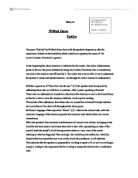Compare William Makepeace Thackeray's 'The Due of the Dead' and Sir Henry Newbolt's 'Vitai Lampada' in terms of their effectiveness of form, structure, language and context.
Q. Compare William Makepeace Thackeray’s ‘The Due of the Dead’ and Sir Henry Newbolt’s ‘Vitai Lampada’ in terms of their effectiveness of form, structure, language and context.
As pre-First World War literary pieces, Thackeray’s ‘The Due of the Dead’ and Newbolt’s ‘Vitai Lampada’ share similar thematic threads, for example in the allusions to the ideals of honour and obligation, evident in the reference to ‘gallant, patient hearts’ and the personification of ‘Honour’ as ‘a name’ , in a contextual establishment where the majority of the upper class – to whom the poetic form of communication appealed most specifically to – lived behind an intricately fabricated façade of religious morality. Moreover, both poems also exhibit an emphasis on structure and rhythm, and while Newbolt opts for the effective poetic form of 8-line stanzas in a tight, regular structure, Thackeray utilises an ordered 4-line stanza structure with 8-syllable lines to maintain a constant rhythmic pace. There is also a prominence of rhyme with both poets employing the ABAB rhyme scheme, and the rhythmic structure explicit most especially in ‘The Due of the Dead’ provides an emphasis on the last words of each line, thereby complementing the poem’s aural quality.
Thackeray presents the central message of ‘The Due of the Dead’ effectively through the division of the poem into four distinct sections from the safe, interior home environment ‘with curtains drawn, and lamp trimmed bright’ in lines 1-4, through the heart-rending bombardment of the atrocities and horrors of war in lines 5-8 and the references to courage and honour in lines 9-12, to the culminant address to his readers’ sense of obligation to ‘these brave men’ who have met ‘a soldier’s doom’, in the final verses. Newbolt’s original setting in the first stanza ‘Vitai Lampada’ is also one of relative safety and security in a ‘bumping pitch’ where the only tension or apprehension is the ‘breathless hush’ of the spectators, and the solitary danger is that of failing to win a cricket match. In similarity to ‘The Due of the Dead’, however, as the poem progresses there is a sharp shift to battle imagery as the reader is enlightened to the harsh reality of a war which has caused ‘the sand of the desert’ to become ‘sodden red ’. It is apparent, conversely, that Newbolt’s primary message differs largely from Thackeray’s: while the latter seeks to justify and augment our sense of obligation to dead soldiers, their families, and ‘those they loved best while they were here’, the former seemingly promotes the sense of blind patriotism and jingoism that ironically plagued an indoctrinated English public during the initial stages of the First World War. In retrospect, the motivational ‘voice of a schoolboy’ that ‘rallies the ranks’ in the face of a ‘river of death’ clearly contains a hollow dimension, and Newbolt’s implications can quickly be dismissed as a propagandist viewpoint; however the poignant and persuasive nature of the poet’s message to its target audience must not be underestimated.







